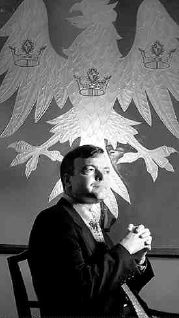Jonathan Chevreau • The National Post • July 22, 2000
 Chris Bolin, National Post Chris Bolin, National PostSteve Rive of Barclays Global Investors is behind the firm's big push of exchange-traded fund products into Canada. |
A year ago, Paul Bates, president and chief executive of discount brokerage Charles Schwab Canada, issued a controversial prediction at the annual conference of the Investment Funds Institute of Canada. When he predicted "the end of the mutual fund industry as we know it," there was a visible stir in the audience of mutual fund executives.
Few in attendance really expected a viable alternative in managed money to start making immediate inroads on their business. But in the year since that prediction was made, a new hybrid alternative to traditional mutual funds called exchange-traded funds (ETFs) appears to have achieved critical mass -- they have experienced an explosive rise in new product announcements, investor interest and media coverage.
Since their modest debut in the early 1990s -- Canada pioneered them with TIPs or Toronto index participation shares -- ETFs now account for US$44-billion worth of transactions on the American Stock Exchange. They allow investors to buy and sell baskets of stocks in major indexes, single countries or single industries.
ETFs have particular appeal for the do-it-yourself crowd who value low management fees and passive management. Their tax advantages appeal to a long-term buy-and-hold investor, but they also have attractive attributes for day traders because ETFs can be traded at current market value at any point in the trading day -- unlike open-end mutual funds, which are priced to market at the close of the day.
Momentum-based investors who like to switch between hot sectors of the economy -- like Internet infrastructure, pharmaceuticals or biotechnology -- have also discovered ETFs.
Eric Kirzner, a finance professor at the University of Toronto, likes ETFs because of their ability to save investors from what he calls "gambler's ruin" -- having a good idea of which sector to invest in but picking the wrong stock.
One solution to this is offered by Merrill Lynch. Its HOLDR product (a contraction of holding company depositary receipts) is an ETF that allow investors to make targeted bets on baskets of about 20 stocks in major (primarily U.S.-based) industries, including semiconductor and Internet plays.
Trading mutual funds as if they were stocks has been discouraged by Canada's fund industry. Altamira Investment Services, a no-load fund manager, even limits the number of annual switches for that reason, arguing it incurs costs for the buy-and-hold crowd.
But at least frequent mutual fund switchers aren't hit with transaction charges on no-load funds or interfamily switches of load funds. Do that with ETFs and the low annual management fees will be eclipsed by stiff brokerage fees. That's because, as with stocks, you pay a commission to a broker every time you buy or sell an ETF.
Bates, of Charles Schwab, says he uses ETFs as part of his own personal investment portfolio. This is consistent with his view of "core and explore," because ETFs allow investors to do what Bates terms "pinpoint tailoring" at the periphery of portfolios.
"They don't replace other mutual funds, but certainly they can be an important part of the portfolio."
Bates says mutual funds in the form in which they have existed are an "anachronism -- the manner in which money is managed will change dramatically."
Bates also likes ETFs because they can be sold at their current market price at any time. During the Mexican peso crisis some years back, people with money in ETF products with a Latin American focus were able to minimize their losses by acting quickly, while people in open-end mutual funds had to wait until the next day to see the pricing impact on portfolios.
Thus far, ETFs have primarily been passive vehicles built around stock indexes, as opposed to actively managed funds. U.S. giant Vanguard has even entered the field to fend off the threat to its index mutual funds. Its ETFs are called Vipers, for Vanguard index participation equity receipts. These are ETFs built around five of its most popular index mutual funds, and becom (0.18%). Cadsby's book lists seven advantages and five disadvantages for index mutual funds, compared to five pros and six cons for ETFs (which he refers to as unit investment trusts). Because you pay commissions to a broker to buy and sell, just as with stocks, he views ETFs as requiring a longer hold period to justify the transaction costs.
Other advantages he lists for ETFs are potentially lower capital gains distributions and low risk of tracking error relative to the index. As for disadvantages, he lists the lack of 100% RRSP eligibility, the fact ETFs must be purchased through brokers or discount brokers, ineligibility for regular investment or withdrawal plans, and the fact dividends must be reinvested manually.
Bylo Selhi, a pseudonym used by an advocate of do-it-yourself index funds, agrees that because brokerage fees must be included in the total cost of owning ETFs, "they may not be the best vehicle for investors with smaller accounts, but their generally lower MERs provide competition for conventional funds. This should ultimately benefit all investors." A part of Selhi's Web site, http://www.bylo.org/ipus.html, sums up the tradeoffs.
In addition to giving equity mutual funds a run for their money, ETFs may also offer fixed-income investors a lower cost alternative to both bond mutual funds and strip bonds. The Canadian unit of Barclays Global Investors will shortly introduce an iUnits product that will be based on five-year and 10-year Government of Canada bonds.